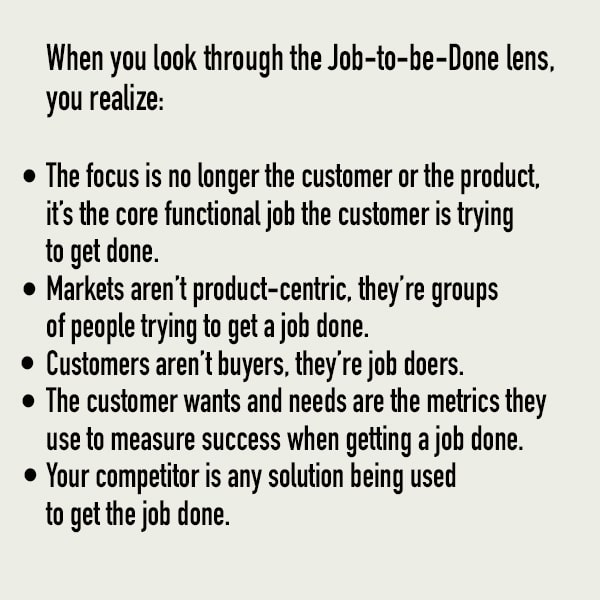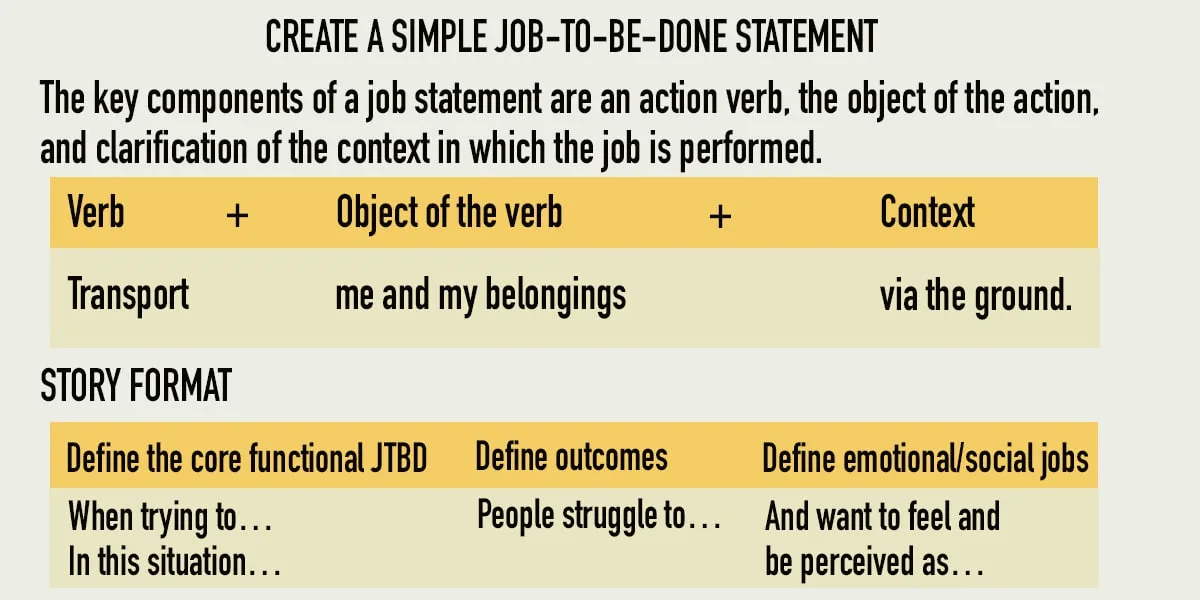Job-to-be-Done thinking and how to eliminate the competition by aligning your strategy and organization around what your customer really wants.
Job-to-be-Done (JTBD) is based on a simple but powerful concept: your customers aren’t buying your product or service, they’re “hiring” it to get a job done. If your product doesn’t do your customers’ job well, they will “fire” your product and look for a new solution.
Finding a new perspective
A question—
Now, stay with me…
 What is the job of a milkshake?
What is the job of a milkshake?
You know, the one you just finished slurping down until there was nothing but gurgling air sounds as you sucked on the straw?
Yes, that’s it, that’s the one. What did you hire that milkshake to do? What was its job?
Another question. Very similar.
What is the job of that mattress? What did you hire (buy) it to do?
We could go on and on… that new LED flat screen TV… or that hybrid crossover SUV… the university degree you have hanging on the wall… or Pat, the new analyst in accounting…
What are their jobs? What did you hire them to do?
Think about this way: when you buy a product or a service, you essentially hire it to help you do a job. “Job” is shorthand for what you are really wanting to accomplish in a given circumstance. A “job” is not a description of what the customer is doing, the solution they’re using, or the steps they’re taking to get a job done. Rather, the “job-to-be-done” is a statement that embodies what the customer is ultimately trying to accomplish.
If a product does the job well (like the milkshake), the next time you’re confronted with the same job (need, want), you tend to hire that product again. And if it does a crummy job, you’ll “fire” it and look for an alternative.
And that’s Jobs-to-be-Done (JTBD), or “Jobs Theory” in a nutshell.
What is the Job-to-be Done?
 The job-to-be-done describes, with precision, what a group of people are trying to achieve or accomplish in a given situation. A job-to-be-done could be a task that people are trying to accomplish, a goal or objective they’re trying to achieve, a problem they’re trying to resolve, something they’re trying to avoid, or anything else they’re trying to accomplish.
The job-to-be-done describes, with precision, what a group of people are trying to achieve or accomplish in a given situation. A job-to-be-done could be a task that people are trying to accomplish, a goal or objective they’re trying to achieve, a problem they’re trying to resolve, something they’re trying to avoid, or anything else they’re trying to accomplish.
When your product helps your customer overcome their struggle by getting their job done faster and more accurately this reduces your customers’ anxiety and significantly increases the likelihood of new and repeat customer purchases.
The JTBD perspective dates back to Theodore Levitt who famously said in the 1960s, “customers don’t want a quarter-inch drill, they want a quarter-inch hole.” If your company’s going to grow, everyone on your team should understand what your customers’ unmet needs are and how you are going to build, market, and sell a product that satisfies those unmet needs better than your competitors.
Where to start.
Instead of starting with ideas for a product and its features, your team should start with customer needs—with the objective to satisfy unmet needs better that the alternatives in your market.
Your customers know what job they’re trying to get done—independent of the solution they’re using or what alternative solutions are possible. Defining the job-to-be-done first—independent of solutions—opens the door to breakthrough thinking and breakthrough products.
Although jobs are functional, there are emotional and social components. As a customer uses a product, they often want to feel a certain way and be perceived in a certain light by their peers and/or friends and others. The way they want to feel and be perceived constitutes their emotional and social jobs-to-be-done.
Understanding the emotional and social components of the job-to-be-done will bring you rich insights that can lead to the creation of a value proposition that resonates with customers at both a functional and emotional level.
Jobs-to-be-Done shows that, in the end, people aren’t loyal to companies or brands. They’re loyal to getting a job done better (faster, more predictably and with higher output/throughput) and/or more cheaply. They replace existing products and services with those that help them achieve these goals.





